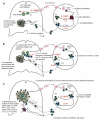The role of cytokines in the initiation, expansion, and control of cellular immunity to tuberculosis
- PMID: 19161425
- PMCID: PMC4298252
- DOI: 10.1111/j.1600-065X.2008.00702.x
The role of cytokines in the initiation, expansion, and control of cellular immunity to tuberculosis
Abstract
Tuberculosis (TB) results from an interaction between a potent immune response and a chronically persistent pathogen. The ability of Mycobacterium tuberculosis (Mtb) to induce a strong immune response while being able to resist the ability of the host to clear bacteria provides an excellent tool with which to investigate the role of specific cytokine pathways on the induction, expansion, and control of the effector T-cell response. In this review, the role of interleukin-12p40 (IL-12p40), IL-12p70, IL-23, and IL-27 in the immune response to Mtb are described. We show that IL-12(p40)(2) acts to mediate the activation of dendritic cells to become responsive to homeostatic chemokines. We also show that IL-12p70 is required for the optimal interferon-gamma (IFN-gamma) T-cell response, which is required for control of Mtb growth. IL-23 can induce IFN-gamma responses in the lung if IL-12 is not present, but its major role is in supporting the IL-17 response within the lung. Neither IL-23 nor IL-17 is required for early control of Mtb in the lung. IL-23 and IL-17, however, can be instrumental in vaccine-induced protection. Finally, IL-27 limits protective immunity in the lung, but it is also required for long-term survival. These cytokines are therefore key players in the immune response to TB.
Figures



References
-
- Dye C, Scheele S, Dolin P, Pathania V, Ravi-glione M. Global burden of tuberculosis. Estimated incidence, prevalence, and mortality by country. JAMA. 1999;282:677–686. - PubMed
-
- Corbett EL, et al. The growing burden of tuberculosis: global trends and interactions with the HIV epidemic. J Arch Intern Med. 2003;163:1009–1021. - PubMed
-
- North R, Jung Y. Immunity to tuberculosis. Annu Rev Immunol. 2004;22:599–623. - PubMed
-
- Colditz G, et al. Efficacy of BCG vaccine in the prevention of tuberculosis. Meta-analysis of the published literature. JAMA. 1994;271:698–702. - PubMed
-
- Trunz B, Fine P, Dye C. Effect of BCG vaccination on childhood tuberculous meningitis and miliary tuberculosis worldwide: a meta-analysis and assessment of cost-effectiveness. Lancet. 2006;367:1173–1180. - PubMed
Publication types
MeSH terms
Substances
Grants and funding
LinkOut - more resources
Full Text Sources
Other Literature Sources
Medical

